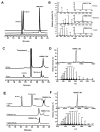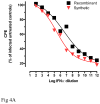Total chemical synthesis of human interferon alpha-2b via native chemical ligation
- PMID: 25810135
- PMCID: PMC4480187
- DOI: 10.1002/psc.2760
Total chemical synthesis of human interferon alpha-2b via native chemical ligation
Abstract
Interferon-alpha (IFNα) is a cytokine that orchestrates innate and adaptive immune responses and potently inhibits proliferation of normal and tumor cells. These properties have warranted the use of IFNα in clinical practice for the treatment of several viral infections and malignancies. However, overexpression of IFNα leads to immunopathology observed in the context of chronic viral infections and autoimmune conditions. Thus, it is desirable to develop therapeutic approaches that aim at suppressing excessive IFNα production. To that end, artificial evolution of peptides from phage display libraries represents a strategy that seeks to disrupt the interaction between IFNα and its cell surface receptor and thus inhibit the ensuing biological effects. Mirror-image phage display that screens peptide libraries against the D-enantiomer is particularly attractive because it allows for identification of proteolysis-resistant D-peptide inhibitors. This approach, however, relies on the availability of chemically synthesized D-IFNα composed entirely of D-amino acids. Here, we describe the synthesis and biological properties of IFNα2b of 165 amino acid residues produced by native chemical ligation, which represents an important first step toward the discovery of D-peptide antagonists with potential therapeutic applications.
Keywords: interferon; native chemical ligation; peptide synthesis; synthetic protein.
Copyright © 2015 European Peptide Society and John Wiley & Sons, Ltd.
Figures






Similar articles
-
Creation of interferon-alpha8 mutants with amino acid substitutions against interferon-alpha receptor-2 binding sites using phage display system and evaluation of their biologic properties.J Interferon Cytokine Res. 2009 Mar;29(3):161-70. doi: 10.1089/jir.2008.0038. J Interferon Cytokine Res. 2009. PMID: 19196068
-
Synthesis of tumor necrosis factor α for use as a mirror-image phage display target.Org Biomol Chem. 2016 Jun 21;14(23):5298-303. doi: 10.1039/c6ob00824k. Epub 2016 May 23. Org Biomol Chem. 2016. PMID: 27211891 Free PMC article.
-
Targeting Jurkat T Lymphocyte Leukemia Cells by an Engineered Interferon-Alpha Hybrid Molecule.Cell Physiol Biochem. 2017;42(2):519-529. doi: 10.1159/000477601. Epub 2017 Jun 5. Cell Physiol Biochem. 2017. PMID: 28578326
-
Harnessing the power of transition metals in solid-phase peptide synthesis and key steps in the (semi)synthesis of proteins.Chem Soc Rev. 2021 Mar 1;50(4):2367-2387. doi: 10.1039/d0cs01156h. Chem Soc Rev. 2021. PMID: 33432943 Review.
-
Intramolecular acyl transfer in peptide and protein ligation and synthesis.J Pept Sci. 2015 Mar;21(3):139-47. doi: 10.1002/psc.2749. Epub 2015 Jan 30. J Pept Sci. 2015. PMID: 25641053 Review.
Cited by
-
Drug repurposing approach to fight COVID-19.Pharmacol Rep. 2020 Dec;72(6):1479-1508. doi: 10.1007/s43440-020-00155-6. Epub 2020 Sep 5. Pharmacol Rep. 2020. PMID: 32889701 Free PMC article. Review.
References
-
- Tough DF. Type I interferon as a link between innate and adaptive immunity through dendritic cell stimulation. Leukemia & lymphoma. 2004;45:257–64. - PubMed
-
- Theofilopoulos AN, Baccala R, Beutler B, Kono DH. Type I interferons (alpha/beta) in immunity and autoimmunity. Annual review of immunology. 2005;23:307–36. - PubMed
-
- Luft T, Pang KC, Thomas E, Hertzog P, Hart DN, Trapani J, et al. Type I IFNs enhance the terminal differentiation of dendritic cells. Journal of immunology. 1998;161:1947–53. - PubMed
-
- Luft T, Luetjens P, Hochrein H, Toy T, Masterman KA, Rizkalla M, et al. IFN-alpha enhances CD40 ligand-mediated activation of immature monocyte-derived dendritic cells. International immunology. 2002;14:367–80. - PubMed
-
- Montoya M, Schiavoni G, Mattei F, Gresser I, Belardelli F, Borrow P, et al. Type I interferons produced by dendritic cells promote their phenotypic and functional activation. Blood. 2002;99:3263–71. - PubMed
Publication types
MeSH terms
Substances
Grants and funding
LinkOut - more resources
Full Text Sources
Other Literature Sources
